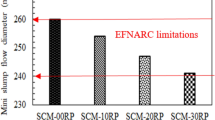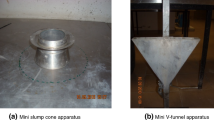Abstract
Building structures can suffer from mechanical, physical and chemical pathologies. One of the serious hazards that can drastically reduce the service life of concrete structures is fire or high temperatures. The use of fine additive materials (FAM) can be a good way for enhancing the fire resistance of concrete. This paper aims to produce an eco-efficient and cheaper self-compacting mortar (SCM) that has a sufficient resistance to high temperatures, by replacing a part of cement with powders from recycled materials, such as glass and ceramic. Nine mixtures were prepared and tested, one as reference mix and eight containing, separately, different proportions in mass of ceramic and glass powders with 5, 15, 25 and 50%. In order to study the behavior of SCM at high temperatures, a total of 135 specimens of 40 × 40 × 160 mm were cast and left cured for 28 days and then subjected to different temperatures (400 °C, 600 °C, 800 °C and 1000 °C) for 2 h. The degradation was assessed by measuring the loss of mass, compressive strength, flexural strength and ultrasonic pulse velocity (UPV) for each temperature. Under conventional temperature, both of compressive and flexural strength and UPV decreased with introducing ceramic and glass powders. The optimal percentage use of ceramic and glass powders under fire conditions is 5%. This percentage can be increased to 15% or 25% to obtain SCM with acceptable mechanical and physical properties. The replacement of 50% of cement with glass powder caused a significant reduction in the mechanical performance of SCM mixture compared to ceramic powder at the same percentage.
















Similar content being viewed by others
References
Overview of the demolition waste in the UK. Platform, construction resources and waste (2012). www.wrap.org.uk/CRWP-Demolition-Report-2009.pdf
Bajad, M.N.; Modhera, C.D.; Desai, A.K.: Effect of glass on strength of concrete subjected to sulphate attack. J. Civ. Eng. Res. Dev. 1(2), 1–13 (2011)
Behim, M.; Cyr, M.; Clastres, P.: Physical and chemical effects of El Hadjar slag used as an additive in cement-based materials. Eur. J. Environ. Civ. Eng. 15(10), 1413–1432 (2011)
Celik, M.Y.; Sabah, E.: Geological and technical characterization of Iscehisar (Afyon-Turkey) marble deposits and the impact of marble waste on environmental pollution. J. Environ. Manage. 87, 106–116 (2008)
Safiuddin, M.; West, J.S.; Soudki, K.A.: Flowing ability of the mortars formulated from self compacting concretes incorporating rice husk ash. Constr. Build. Mater. 25(2), 973–978 (2011)
Brulliard, C.; Cain, R.; Do, D.; Dornom, T.; Evans, K.; Lim, B.; Olesson, E.; Young, S.: The Australian recycling sector, report. Department of Sustainability, Environment, Water, Population and Communities (2012)
Torkittikul, P.; Chaipanich, A.: Utilization of ceramic waste as fine aggregate within Portland cement and fly ash concretes. Cement Concr. Compos. 32(6), 440–449 (2010)
Tennich, M.; Kallel, A.; Ben, Ouezdou M.: Incorporation of fillers from marble and tile wastes in the composition of self-compacting concretes. Constr. Build. Mater. 91, 65–70 (2015)
Kumar, R.; Samanta, A.K.; Roy, D.K.S.: Characterization and development of ecofriendly concrete using industrial wastes. A review. J. Urban Environ. Eng. 8(1), 98–108 (2014)
Lee, H.; Hanif, A.; Usman, M.; Sim, J.; Oh, H.: Performance evaluation of concrete incorporating glass powder and glass sludge wastes as supplementary cementing material. J. Clean. Prod. 170, 683–693 (2018)
Boukhelkhal, A.; Azzouz, L.; Benabed, B.; Belaïdi, A.S.E.: Strength and durability of low-impact environmental self-compacting concrete incorporating waste marble powder. J. Build. Mater. Struct. 4, 31–41 (2017)
Azeredo, G.; Diniz, M.: Self-compacting concrete obtained by the use of kaolin wastes. Constr. Build. Mater. 38, 515–523 (2013)
Lasseuguette, E.; Burns, S.; Simmons, D.; Francis, E.; Huang, Y.: Chemical, microstructural and mechanical properties of ceramic waste blended cementitious systems. J. Clean. Prod. 211, 1228–1238 (2019)
Boukhelkhal, A.; Benabed, B.: Fresh and hardened properties of self-compacting repair mortar made with a new reduced carbon blended cement. J. Silicate Based Compos. Mater. 71(4), 108–113 (2019)
Omrane, M.; Kenai, S.; Kadri, E.H.; Ait, Mokhtar A.: Performance and durability of self-compacting concrete using recycled concrete aggregates and natural pozzolan. J. Clean. Prod. 165, 415–430 (2017)
Omran, A.; Tagnit-Hamou, A.: Performance of glass-powder concrete in field applications. Constr. Build. Mater. 109, 84–95 (2016)
Vieira, T.; Alves, A.; Brito, J.D.; Correia, J.R.; Silva, R.V.: Durability-related performance of concrete containing fine recycled aggregates from crushed bricks and sanitary ware. Mater. Des. 90, 767–776 (2016)
Persson, B.: Fire resistance of SCC. Mater. Struct. 37, 575–584 (2004)
Uysal, M.: Self-compacting concrete incorporating filler additives: performance at high temperatures. Constr. Build. Mater. 26(1), 701–706 (2012)
Zemri, C.; Bouiadjra, M.B.: Comparison between physical–mechanical properties of mortar made with Portland cement (CEMI) and slag cement (CEMIII) subjected to elevated temperature. Case Stud. Constr. Mater. 12, 1–12 (2020)
Nadeem, A.; Ali Memon, S.; Yiu, Lo T.: The performance of Fly ash and Metakaolin concrete at elevated temperatures. Constr. Build. Mater. 62, 67–76 (2014)
Mohit, M.; Sharifi, Y.: Thermal and microstructure properties of cement mortar containing ceramic waste powder as alternative cementitious materials. Constr. Build. Mater. 223, 643–656 (2019)
Morsy, M.S.; Al-Salloum, Y.A.; Abbas, H.; Alsayed, S.H.: Behavior of blended cement mortars containing nano-metakaolin at elevated temperatures. Constr. Build. Mater. 35, 900–905 (2012)
EN 196-1: Methods of Testing Cement—Part 1: Determination of Strength (2002)
ASTM C597-16: Standard Test Method for Pulse Velocity Through Concrete. ASTM International, West Conshohocken, PA (2016)
Heikal, M.: Effect of elevated temperature on the physico-mechanical and microstructural properties of blended cement pastes. Build. Res. J. 56(2–3), 157–172 (2008)
Khoury, G.A.; Majorana, C.E.; Pesavento, F.; Schrefler, B.A.: Modelling of heated concrete. Mag. Concr. Res. 54(2), 77–101 (2002)
Horszczaruk, E.; Sikora, P.; Cendrowski, K.; Mijowska, E.: The effect of elevated temperature on the properties of cement mortars containing nanosilica and heavyweight aggregates. Constr. Build. Mater. 137, 420–431 (2017)
Behnood, A.; Ziari, H.: Effects of silica fume addition and water to cement ratio on the properties of high-strength concrete after exposure to high temperatures. Cement Concr. Compos. 30, 106–112 (2008)
Zhang, B.; Bicanic, N.: Residual fracture toughness of normal-and high-strength gravel concrete after heating to 600°C. ACI Mater. J. 99(3), 217–226 (2002)
Hertz, K.D.: Concrete strength for fire safety design. Mag. Concr. Res. 57(8), 445–453 (2005)
Komonen, J.; Renttala, V.: Effect of high temperature on the pore structure and strength of plain and polypropylene fiber reinforced cement pastes. Fire Technol. 39, 23–34 (2003)
Ouldkhaoua, Y.; Benabed, B.; Abousnina, R.; Kadri, E.-H.: Experimental study on the reuse of cathode ray tubes funnel glass as fine aggregate for developing an ecological self-compacting mortar incorporating metakaolin. J. Build. Eng. 27, 100951 (2020)
Laidani, Z.E.A.; Benabed, B.; Abousnina, R.; Gueddouda, M.K.; Khatib, J.: Potential pozzolanicity of Algerian calcined bentonite used as cement replacement: optimisation of calcination temperature and effect on strength of self-compacting mortars. Eur. J. Environ. Civ. Eng. (2020). https://doi.org/10.1080/19648189.2020.1713898
Ramachandran, V.S.; Feldman, R.F.; Beaudoin, J.J.: Concrete Science Treatise on Current Research. Heyden and Son Ltd, London (1981)
Noumowé, A.: Effet de hautes températures (20–600°C) sur le béton, Cas particulier du béton à hautes performance. Thèse de Doctorat, INSA Lyon (1995)
Alarcon-Ruiz, L.; Platret, G.; Massieu, E.; Ehrlacher, A.: The use of thermal analysis in assessing the effect of temperature on cement paste. Cement Concr. Res. 35, 609–613 (2005)
Zhou, Q.; Glasser, F.P.: Thermal stability and decomposition mechanisms of ettringite at < 120°C. Cem. Concr. Res. 31, 1333–1339 (2001)
Divet, L.; Arnaud, S.; Derobert, X.; Fasseu, P.; Faure, R.-M.; Larive, C.; Naquin, B.; Olivier, G.: Méthodes d’essai des LCPC N°62, Présentation des techniques de diagnostic de l’état d’un béton soumis à un incendie, Laboratoire Central des Ponts et Chaussées, 2005 Décembre
Fares, H.; Noumowe, A.; Remond, S.: Self-consolidating concrete subjected to high temperature: mechanical and physicochemical properties. Cement Concr. Res. 39(12), 1230–1238 (2009)
Ismail, M.; Ismail, M.E.G.; Muhammad, B.: Influence of elevated temperatures on physical and compressive strength properties of concrete containing palm oil fuel ash. Constr. Build. Mater. 25, 2358–2364 (2011)
Bazant, Z.P.; Kaplan, M.F.: Concrete at High Temperatures, Material Properties and Mathematical Models. Longman House, Burnt Mill (1996)
Uysal, M.; Yilmaz, K.; Ipek, M.: Properties and behavior of self-compacting concrete produced with GBFS and FA additives subjected to high temperatures. Constr. Build. Mater. 28, 321–326 (2012)
Whitehurst, E.A.: Soniscope tests concrete structures. J. ACI 47, 443–444 (1951)
Author information
Authors and Affiliations
Corresponding author
Rights and permissions
About this article
Cite this article
Boukhelkhal, A. Assessment of the Behavior Under Conventional and High Temperatures of Eco-friendly Self-Compacting Mortar Containing Glass and Ceramic Powders. Arab J Sci Eng 47, 4821–4831 (2022). https://doi.org/10.1007/s13369-020-05306-8
Received:
Accepted:
Published:
Issue Date:
DOI: https://doi.org/10.1007/s13369-020-05306-8




